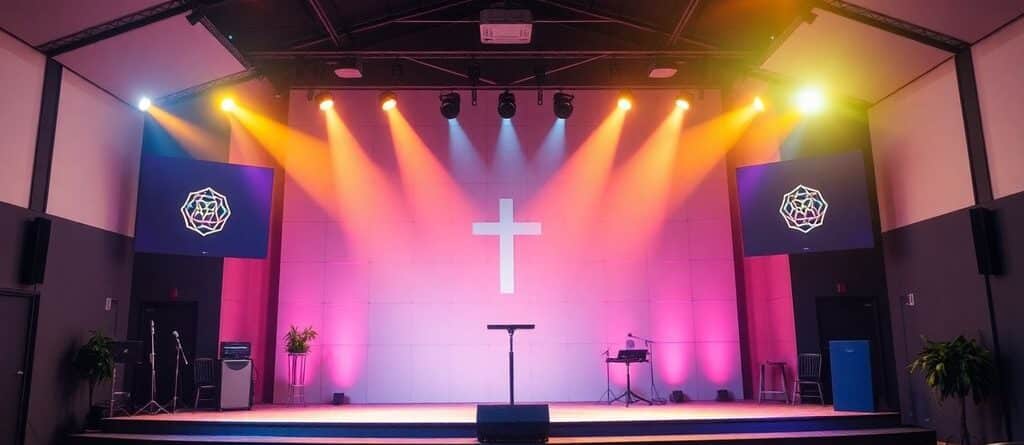Innovative Modern Small Church Stage Design: Transform Your Space with Style
Creating a modern small church stage design can significantly enhance the worship experience by transforming the space into something visually engaging and functional. Whether you’re working with a tight budget or looking to incorporate new technology, there are plenty of creative ideas to make your church stage stand out. This article explores innovative approaches to small church stage design that can help you create a welcoming environment for your congregation.
Key Takeaways
- Incorporate natural elements for a warm, inviting atmosphere.
- Use multi-purpose furniture to maximize functionality.
- Keep the design minimalistic to avoid distractions during worship.
- Leverage technology for audio-visual integration and engagement.
- Embrace seasonal themes for dynamic stage transformations.
Creative Approaches to Modern Small Church Stage Design
Incorporating Natural Elements
Bringing the outdoors inside can really transform a small church stage. Think about using things like real plants, wood accents, or even a small water feature if space allows. These elements can create a calming and welcoming atmosphere. It’s a great way to connect with creation and remind people of the beauty of the natural world. Just make sure to choose plants that are easy to care for and won’t cause allergies.
- Use potted plants of varying heights to add depth.
- Incorporate wooden planks as a backdrop for a rustic feel.
- Consider a small indoor fountain for a soothing sound.
Natural elements can bring a sense of peace and tranquility to the worship space, helping congregants feel more connected to God’s creation.
Utilizing Multi-Purpose Furniture
Space is often at a premium in smaller churches, so furniture needs to pull double duty. Instead of bulky, single-use items, opt for pieces that can be easily reconfigured or serve multiple purposes. For example, stackable chairs, modular staging platforms, or even storage benches can be incredibly useful. This approach not only saves space but also allows for greater flexibility in stage design. Think about how the furniture can be used for different services or events. You can find great deals on used church furniture online.
- Stackable chairs for easy storage and rearrangement.
- Modular staging platforms for creating different levels.
- Storage benches for keeping equipment out of sight.
Emphasizing Minimalism
Sometimes, less is more. A minimalist approach can be incredibly effective in a small church setting. By focusing on clean lines, simple shapes, and a limited color palette, you can create a sense of spaciousness and calm. The goal is to create a focal point without overwhelming the space. This approach also helps to keep the focus on the message and the worship experience, rather than the stage design itself. It’s all about creating a distraction-free environment that encourages reflection and connection.
- Use a neutral color palette to create a sense of calm.
- Focus on one or two key design elements.
- Keep the stage clutter-free and organized.
Budget-Friendly Stage Design Solutions
Let’s be real, not every church has a ton of money to throw at fancy stage designs. But that doesn’t mean you can’t create a welcoming and inspiring space! It’s all about getting creative and resourceful. Focus on maximizing impact without breaking the bank.
DIY Decor Ideas
DIY projects are your best friend when you’re on a tight budget. Instead of buying expensive decorations, consider making your own. This can be a fun activity for the whole community, too! Here are some ideas:
- Paper Decorations: Simple paper banners, origami, or paper flowers can add a pop of color and texture. They’re cheap and easy to make.
- Fabric Backdrops: Use inexpensive fabrics like muslin or burlap to create backdrops. You can dye them, paint them, or hang them in interesting ways.
- String Lights: A few strands of string lights can instantly create a warm and inviting atmosphere. Use them to highlight architectural features or create a focal point.
Repurposing Existing Materials
Before you buy anything new, take a look around your church and see what you already have. You might be surprised at what you can repurpose! Old furniture, fabric scraps, and even cardboard boxes can be transformed into something new and beautiful. For example, you can use old pallets to create a rustic backdrop or turn old doors into a unique stage prop. Think outside the box and see what treasures you can find!
Community Involvement in Design
Don’t be afraid to ask for help from your congregation! Chances are, there are plenty of talented people in your church who would be happy to contribute their skills and time. This is a great way to save money and build community at the same time. Maybe someone is good at painting, sewing, or woodworking. Get people involved in creating worship music stage design elements.
Getting the community involved not only saves money but also fosters a sense of ownership and pride in the church’s appearance. When people contribute their time and talents, they’re more invested in the space and the worship experience.
Lighting Techniques for Enhanced Worship Experience

Lighting can really change the feel of a worship space. It’s not just about seeing; it’s about feeling. Getting the lighting right can make a huge difference in how people connect with the service.
Ambient Lighting Strategies
Ambient lighting is your base layer. Think of it as the overall mood setter. You want something that’s welcoming and warm, not harsh or sterile. Dimmers are your friend here. Being able to adjust the brightness lets you adapt to different parts of the service. For example, you might want brighter lights for singing and softer lights for prayer. Consider using custom signage solutions to subtly direct attention without disrupting the ambiance.
- Use warm-toned bulbs to create a welcoming atmosphere.
- Install dimmers to adjust the brightness as needed.
- Consider uplighting to highlight architectural features.
Color Psychology in Lighting
Color does things to our brains. It’s a fact. Blue can be calming, red can be energizing, and green can feel natural. Using color strategically can really amplify the message of a service. But, a little goes a long way. Overdoing it can be distracting. Think about using color washes to subtly shift the mood during different segments of the service.
- Blue: Calming, reflective
- Green: Peaceful, natural
- Yellow: Joyful, energetic
Innovative Use of LED Technology
LEDs are where it’s at these days. They’re energy-efficient, long-lasting, and super versatile. You can get them in pretty much any color and brightness you could want. Plus, they’re easy to control, so you can create some really cool effects. Think about using LED strip lights to highlight architectural details or LED spotlights to focus attention on the speaker. LEDs offer a cost-effective and flexible way to transform your stage lighting.
- Energy efficiency reduces operating costs.
- Long lifespan minimizes maintenance.
- Versatile color options allow for creative expression.
Good lighting design isn’t just about having fancy lights. It’s about using light to tell a story, to create a mood, and to help people connect with something bigger than themselves. It’s about making the space feel sacred and welcoming.
Incorporating Technology in Stage Design
Technology can really change how a small church uses its stage. It’s not just about having fancy gadgets; it’s about making the worship experience more engaging and accessible. Let’s look at some ways to bring tech into your stage design.
Audio-Visual Integration
Getting your audio and video to work together smoothly is super important. Think about how sound and visuals can complement each other during services. This could mean using screens to display lyrics, Bible verses, or even short videos that go along with the sermon. Good sound is a must, so invest in quality microphones and speakers. Here’s a simple table showing some basic AV equipment and their uses:
| Equipment | Use |
|---|---|
| Microphones | Capturing vocals and instruments |
| Speakers | Projecting sound to the congregation |
| Projector/Screen | Displaying visuals |
| Mixing Console | Controlling audio levels |
Interactive Elements for Engagement
Think about ways to get the congregation involved. This could be as simple as using a vinyl lettering to display questions on the screen during the sermon and letting people text in their answers. Or, you could use interactive lighting that changes based on the music. The goal is to make people feel like they’re part of the service, not just watching it. Here are a few ideas:
- Live polls during the sermon
- Social media integration (displaying tweets or posts)
- Interactive prayer requests via text
Live Streaming Considerations
If you’re live streaming your services, you need to think about how the stage looks on camera. Make sure the lighting is good and that the background isn’t too distracting. Also, consider the sound quality for online viewers. It might be different than what sounds good in the church itself. You might need extra microphones or a separate audio mix for the live stream.
Live streaming is a great way to reach people who can’t attend in person, but it’s important to do it well. Poor audio or video quality can be a real turn-off. Make sure you test everything before the service starts!
Seasonal and Thematic Stage Transformations
It’s easy to get stuck in a rut with your church stage design. But changing things up for different seasons and themes can really make a difference. It keeps things fresh and helps people connect with the message in a new way. Themed stages are specifically designed to support certain holidays, festivals, events, and sermon series in a church.
Designing for Holidays
Holidays are a great opportunity to transform your stage. Think about what elements really capture the spirit of the holiday. For Christmas, maybe it’s a simple nativity scene or some Christmas trees. For Easter, you could focus on symbols of new life, like flowers or a cross draped in white fabric. The key is to make it feel special and relevant to the occasion.
Here are some ideas for holiday stage designs:
- Christmas: Nativity scene, Christmas trees, stars, warm lighting.
- Easter: Cross with white fabric, lilies, sunrise backdrop.
- Thanksgiving: Cornucopia, autumn leaves, harvest theme.
Creating a Year-Round Theme
While seasonal changes are great, having a consistent theme throughout the year can also be effective. This could be something simple like a color scheme or a recurring visual element. A year-round theme helps create a sense of continuity and identity for your church. It doesn’t have to be elaborate, but it should be intentional and reflect your church’s values.
Having a year-round theme doesn’t mean you can’t incorporate seasonal elements. It just provides a foundation to build upon. Think of it as a canvas that you can adapt and change as needed.
Flexibility in Stage Setup
No matter what theme you choose, flexibility is key. Your stage should be easy to adapt for different services and events. Modular elements are great for this. Consider using modular stage design that can be easily moved or reconfigured. This allows you to create different looks without a lot of effort or expense. Think about how you can use lighting, fabrics, and other decorations to quickly change the feel of the stage.
Here are some ways to ensure flexibility:
- Use modular furniture and decorations.
- Invest in versatile lighting options.
- Have a system for quickly changing backdrops and fabrics.
The Role of Art in Worship Spaces
Art can really change how people experience worship. It’s not just about decoration; it’s about creating an environment that speaks to the soul. Churches have a history of using art to tell stories and connect with people, and bringing that back can make a big difference, even on a small stage. It’s about making the space feel special and set apart.
Visual Storytelling through Art
Art can be a powerful way to communicate messages and tell stories. Think about using paintings, sculptures, or even digital art to illustrate biblical stories or themes from the sermon. It’s a way to engage people visually and help them connect with the message on a deeper level. It doesn’t have to be expensive; even simple, well-chosen pieces can have a big impact. You could even use art to represent the church’s values or mission.
Collaborating with Local Artists
Working with local artists can bring fresh perspectives and talent to your church stage. It’s a great way to support the community and get unique, meaningful artwork. Plus, it can be a lot more affordable than buying art from a gallery. Consider hosting an art contest or reaching out to art students at a nearby college. You might be surprised at the talent that’s right in your backyard. Plus, it’s a great way to get the community involved in the church.
Art Installations that Inspire
Art installations can transform a small church stage into something truly special. These don’t have to be complicated or expensive. Here are some ideas:
- A fabric backdrop with meaningful symbols.
- A display of handmade crosses from church members.
- A collection of nature-inspired art, like branches or stones.
The key is to create something that is both visually appealing and spiritually meaningful. Think about how the installation can enhance the worship experience and help people connect with God. It’s about creating a space that inspires awe and wonder.
Consider using advertising flags to promote the art installation and invite the community to experience it.
Functional Layouts for Small Church Stages

Small church stages often present a unique challenge: maximizing limited space while creating an environment conducive to worship. It’s about being smart with what you have and making every square foot count. The key is to design a layout that supports various activities without feeling cramped or cluttered.
Optimizing Space for Worship
When space is tight, every element on stage needs to earn its place. Think about what’s truly essential for your services. Can the band share a smaller footprint? Is there a way to combine the pulpit and music stand? Consider vertical space too. Shelving or wall-mounted elements can hold equipment or decorations without taking up valuable floor area. Also, think about the flow of movement. Can people easily get on and off the stage without bumping into each other or equipment?
- Prioritize essential elements only.
- Utilize vertical space with shelves or wall mounts.
- Ensure smooth traffic flow on and off stage.
Creating Clear Sightlines
Nothing is worse than attending a service and not being able to see what’s happening on stage. Clear sightlines are important, especially in smaller spaces. This means carefully positioning furniture, speakers, and other equipment so they don’t block the view of anyone in the congregation. Consider the height of the stage itself. Is it high enough for everyone to see, but not so high that it feels disconnected from the audience? Also, think about the angle of the seating. Angled seating can help improve sightlines for people sitting on the sides of the room. You might want to consider indoor banners to help with visibility.
- Arrange furniture to avoid blocking views.
- Consider stage height relative to seating.
- Use angled seating to improve sightlines.
Flexible Stage Configurations
One of the best ways to maximize a small church stage is to design it for flexibility. This means choosing furniture and equipment that can be easily moved or reconfigured to suit different events. Modular stage pieces are a great option, as they can be arranged in various ways to create different looks and functionalities. Think about investing in lightweight, stackable chairs or tables that can be quickly set up or taken down as needed. This allows you to transform the stage from a traditional worship setup to a performance space or a meeting area with minimal effort. This is especially useful if you have small church stage design needs.
- Use modular stage pieces for easy reconfiguration.
- Invest in lightweight, stackable furniture.
- Plan for quick transitions between different setups.
A well-designed small church stage layout is more than just arranging furniture. It’s about creating a space that enhances worship, fosters connection, and serves the diverse needs of the congregation. By carefully considering space optimization, sightlines, and flexibility, you can transform even the smallest stage into a powerful platform for ministry.
Creating a functional layout for a small church stage can make a big difference in how your services feel. Think about how you can arrange your space to make it welcoming and easy for everyone to see and hear. If you want to learn more about designing the perfect stage for your church, visit our website for helpful tips and ideas!
Wrapping It Up
So, there you have it! Revamping your small church stage doesn’t have to be a huge headache or break the bank. With a little creativity and some smart planning, you can create a space that really speaks to your community and enhances worship. Remember, it’s not just about looking good; it’s about making a place where people feel connected to God. Whether you’re using simple materials or getting a bit fancy with lights, the goal is to inspire and uplift. So, roll up your sleeves, gather your team, and start brainstorming. Your church stage could be the next big thing that brings everyone together!
Frequently Asked Questions
What are some creative ideas for decorating a small church stage?
You can use simple decorations like fabric drapes, LED lights, and natural elements like plants to make the stage inviting.
How can I design a stage on a tight budget?
Consider DIY projects, use materials you already have, and involve the church community to help with the design.
What lighting techniques work best for small church stages?
Using soft ambient lighting and colorful LED lights can create a warm and welcoming atmosphere for worship.
How can technology enhance my church stage design?
Incorporating audio-visual equipment and interactive screens can engage the audience and improve the worship experience.
How often should I change the stage design?
It’s a good idea to refresh the stage design for special holidays or events, but you can also have a year-round theme that can be easily adjusted.
Why is stage design important in a church setting?
A well-designed stage helps create a focused and inspiring environment for worship, enhancing the overall experience for everyone.











